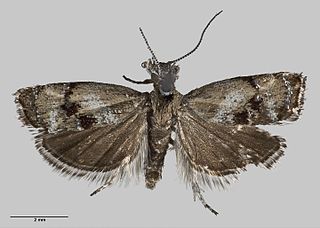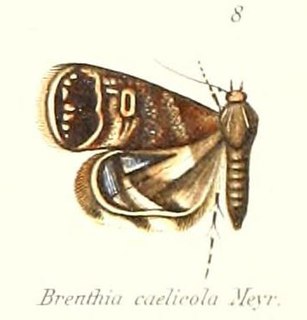| Tortyra malacozona | |
|---|---|
| Scientific classification | |
| Kingdom: | Animalia |
| Phylum: | Arthropoda |
| Class: | Insecta |
| Order: | Lepidoptera |
| Family: | Choreutidae |
| Genus: | Tortyra |
| Species: | T. malacozona |
| Binomial name | |
| Tortyra malacozona Meyrick, 1922 [1] | |
Tortyra malacozona is a moth of the Choreutidae family. It is known from Peru and Costa Rica.

Moths comprise a group of insects related to butterflies, belonging to the order Lepidoptera. Most lepidopterans are moths, and there are thought to be approximately 160,000 species of moth, many of which have yet to be described. Most species of moth are nocturnal, but there are also crepuscular and diurnal species.

Choreutidae, or metalmark moths, are a family of insects in the lepidopteran order whose relationships have been long disputed. It was placed previously in the superfamily Yponomeutoidea in family Glyphipterigidae and in superfamily Sesioidea. It is now considered to represent its own superfamily. The relationship of the family to the other lineages in the group "Apoditrysia" need a new assessment, especially with new molecular data.

Peru, officially the Republic of Peru, is a country in western South America. It is bordered in the north by Ecuador and Colombia, in the east by Brazil, in the southeast by Bolivia, in the south by Chile, and in the west by the Pacific Ocean. Peru is a megadiverse country with habitats ranging from the arid plains of the Pacific coastal region in the west to the peaks of the Andes mountains vertically extending from the north to the southeast of the country to the tropical Amazon Basin rainforest in the east with the Amazon river.
The wingspan is about 16 mm. The forewings are dark grey, with the tips of the scales white, forming a very close minute speckling. A black dot is found near the base in the middle, connected with the costa by a very fine strigula. There is a black dot near the dorsum at one-fifth and there is a fine slightly curved black transverse line at one-third. Near beyond this is a parallel rather dark fuscous streak. In the postmedian area are some irregularly placed fine black dashes and longitudinal lines of scales. The whitish speckling is absent towards the costa on apical third and there is a moderately broad violet terminal fascia, rather broader dorsally, the base of the scales dark and the tips light, forming a fine striation. The hindwings are dark fuscous. [2]

The wingspan of a bird or an airplane is the distance from one wingtip to the other wingtip. For example, the Boeing 777-200 has a wingspan of 60.93 metres, and a wandering albatross caught in 1965 had a wingspan of 3.63 metres, the official record for a living bird. The term wingspan, more technically extent, is also used for other winged animals such as pterosaurs, bats, insects, etc., and other fixed-wing aircraft such as ornithopters. In humans, the term wingspan also refers to the arm span, which is distance between the length from one end of an individual's arms to the other when raised parallel to the ground at shoulder height at a 90º angle. Former professional basketball player Manute Bol stands at 7 ft 7 in (2.31 m) and owns one of the largest wingspans at 8 ft 6 in (2.59 m).

